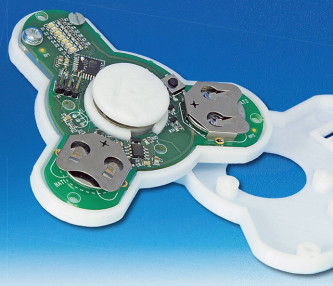Luminous fidget spinner: electronic & mechanical coupling
With this project, full of clever tricks, and in particular Elektor’s approach to it, the concept is carefully documented and explained. In addition, everything you need to construct your own is put at your disposal. The electronics with microcontroller and LEDs, the software for the microcontroller, and the mechanical parts, crafted to guarantee balance: a 3D printed case, a ball bearing and a printed circuit board.

Synchronisation with Hall effect sensor
As presented by Elektor, the implementation of a manual top lets you discover, use and combine your passions: to display short texts and light effects on a few LEDs thanks to POV (Persistence of Vision). Easy to say, but to do it there are some details to master. It’s the good old principle of cinema and television put to work through the thumb and index finger. To synchronise control of the LEDs with the rotational position of the top, i.e to turn them on and off at the right moment, the software needs to know the rotational speed of the top. For this a Hall sensor is used – this is a component, sensitive to magnetic fields, which rotates next to a fixed magnet. An age-old principle, but here it is you who programmes it, and it happens dozens of times per second between your fingers.Electronics, LEDs, µCs, software and mechanicals
With a non-trivial project such as this, and with Elektor’s attention to detail, not only is everything explained in detail, but everything you need to complete your own construction is put at your disposal. The electronics with microcontroller and LEDs, the software for the microcontroller, and the mechanical parts, crafted to guarantee balance: a 3D printed case, a ball bearing and a printed circuit board.All that’s missing is your skilful hands to assemble it and your curiosity to interest yourself in it.

